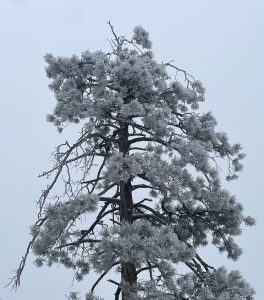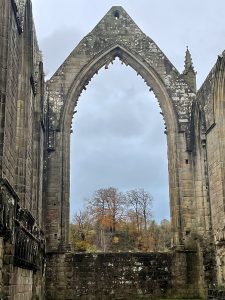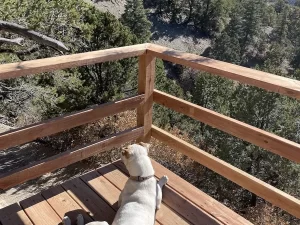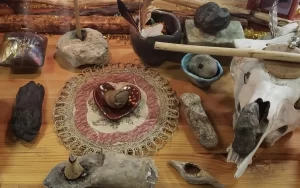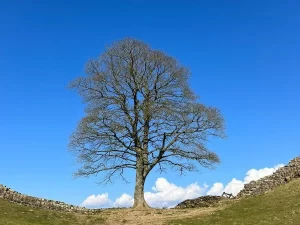The Background
Life’s rich path recently took me from rural France to New Mexico in one fell swoop. After acclimatizing for a while, I began to get excited about a new challenge, learning the herbs from this unique part of the globe. I arrived in autumn and so roots were in season and as I love root medicine, I was exited to meet the natives. The first to make itself known, thanks to my guide Florian was osha but that is another story. Today I want to talk about the second root that an herbalist friend, Christine Herbert told me about when she heard I was settling in New Mexico. I asked Florian about it and he guided me straight towards Yerba mansa (Anemopsis californica).
Off we went one late afternoon with a bag and trowel to what is known as the bosque. The bosque refers to a gallery forest made up of cotton wood trees (Populus deltoides) and coyote willow (Salix exigua). They follow the Rio Grande as it winds its way through New Mexico. Not far from the river’s edge grows a ground cover with an earthy aroma that subtly scents the whole bosque. It was late winter and all that remained of its beautiful, very individual looking white flowers were some wilted dried carcasses. Their aroma lived on, however even in their dried, brown state.
Harvesting
It felt so good to get my hands back in touch with the earth and this time a new corner of it. What an honor to be initiated in this lifetime to a whole new medicinal flora, habitat and history.
I started to dig into the slightly moist, deep riverside earth. I soon realized that Yerba mansa is made up of a whole network of rhizomes all joined together, somewhere there was a mother. Like nettle (Urtica dioica) everyone was joined to the other. This was an organism, a living network not just a plant.
It felt so satisfying getting down low onto the woodland floor and feeling the damp roots with my hands. I gently dug around until finally I could free one and put it triumphantly into the bag.
As I was doing this I felt the presence of an old woman. I thought of the history of the plant and the people that had harvested it for generations as part of their yearly rituals. I felt the old female healers who had always quietly gone down to the bosque and done exactly what I was doing. Somehow I was receiving an initiation into this medicine of New Mexico. I wasn’t alone and I felt honored to meet such a beautiful and powerful plant being.
We silently, reverently filled the bag. The dark heavy, soil-clad black roots showed the first signs of life with tiny pink tipped shoots accompanying them.
This seemed to echo the fact that today was Imbolc, the ancient Celtic festival that celebrates the return of the sun after winter and the beginning of the agricultural year. Imbolc comes from the Gaelic word, ‘oimelic’ meaning ewe’s milk and symbolized the milk of life flowing again. The seeds were sprouting and the shoots pushing. The darkness was still there but the first signs of life were manifesting. This was evident in the roots and it seemed just the right moment to harvest them. It felt as if they were waking up after winter but the plant’s vital energy was still deeply imbedded in them. The new growth was embryonic and hadn’t left the warmth and comfort of the nourishing rhizomes yet. I could also feel Imbolc’s message inside myself. I felt the tiny thrusts of new birth and yet the shadowy, silent passage of winter still had a grip.
As we were preparing to leave the site, we paid attention to filling in any holes we had left from digging up the roots. I always remember to leave things as they were. It was important to show no signs of our presence except maybe the slightly more intense now familiar odor wafting through the trees.
Florian had prepared a special offering to thank the plant for letting us take some of it. As we turned to leave, our dog was uncharacteristically but vehemently barking at a tree. I looked to see if there was an animal, a squirrel maybe up there but nothing, a totally bare, winter-naked tree. We called him but he persisted, making us look again, trying to understand but nothing was visible. We pulled him away and I thought to myself, ‘that was the spirit of the woman linked to the Yerba mansa, she had been looking down at us from the tree. Dogs have such strong instincts for that type of thing’ I didn’t say anything to the others at this point, it was just one of those fleeting personal thoughts.
Getting to know the plant deeper
Back at home we prepared the roots so we could make medicine with them. I never like scrubbing the roots too hard as like root vegetables, I think at least some of the ‘goodness’ is just under the first dermal layer. I rinse them and get the soil off with my hands. This is a long process and takes several passages in order to get them to an acceptable state. Although it is time-consuming it is an important part of the process. As we touch and caress the newly excavated roots we begin to develop our relationship with them. Through their texture and form their message and resonance mingles with our own. After washing the roots, I then cut them up into small slices. I always do this before letting them dry as most roots become extremely hard and difficult to cut when dry. These particular ones were a reddish-pink color inside.
The meaning of its name sounded like an old, rural, female title rather than a plant name. Yerba means herb and ‘mansa’ means meek, tame or gentle in Spanish. I was surprised as this plant and its spirit definitely didn’t feel meek or tame. Gentle, yes there was a gentleness or softness somewhere there but that was just a thread in what revealed itself to be an extremely powerful plant. I looked further for more translations of the word ‘mansa’ and found, ‘harmless’, ‘peaceful’ and ‘quiet. I am always intrigued by how plants got their names. Especially their common, local names as these often reflect how people in the past related to and thought of the plant. Yerba Mansa has apparently been used for centuries in the South west of the United States and is also referred to as; apache beads, lizard tail and swamp root.
Reading about the plant’s properties, I realized that it had many ranging from anti-viral, mucolytic, antibacterial, anti-inflammatory, stomachic to showing potential for healing cervical and uterine cancers and much more. Wow, this really is a major medicinal,
I felt great gratitude to Christine who had pointed out that I was living close by. I am only just discovering Yerba Mansa and have no experience of using it in practice myself so it would be pretentious to try and talk about its uses. There are many colleagues out there who have plenty to say on the subject based on years of experience. I suggest for this you refer to Sam Coffman or others.
However, my story does not stop here.
Yerba Mansa and I continued our journey of getting to know each other. I read that it could be effective for cervical and uterine cancers. This made me prick up my ears as I was, at the time on a healing journey through cervical cancer.
Constituents
Wee came across a study called; ‘Chemotypic Variation of Essential Oils in the Medicinal Plant, Anemopsis californica’ (1) This was right up our street as both of us have a keen interest in aromatic medicine. We looked at the typical, aromatic constituents identified in Yerba Mansa and these included monocyclic constituents such as; cymene, limonene, piperitone and thymol, bicyclic constituents such as a-pinene, 1.8 cineol and myrtenol and monoterpenoid and phenylpropanoid constituents; methyleugenol, isoeugenol and elemicin.
Three distinct chemotypes were detected depending on where the plant was harvested. One was characterized by high elemicin concentrations, a second by high methyleugenol concentrations and the third by high piperitone and thymol concentrations. We were intrigued to find out more about elemicin, which was found in high quantities, in some cases more than 50% especially in Northern New Mexico. This is where we harvested the Yerba Mansa.
Elemicin is an allylbenzene essential oil found in large quantities in Zingiber niveum and an elemicin chemotype of Cinnamon myrtle essential oil. It is also found in the essential oils of nutmeg, ginger grass, elemi and many other plants. It’s believed to be partially responsible for the hallucinogenic effects of nutmeg (2). When we looked at the structure, we noticed that it looked very similar to safrol.

So, it was beginning to look like some of Yerba Mansa’s most interesting information maybe being held in its aromatic, volatile element. This made sense to us in the way its odor gently infuses and penetrates the whole bosque
Distilling
We decided to distill a large proportion of the plant material we had harvested and that was now drying.
Using our 35 liter copper still, we left the dried Yerba Mansa root to macerate overnight in the filtered rain water we were using to distill. This allowed the roots to rehydrate and the water soluble constituents to slowly start to leave the root and infuse into the water.
The following day, we added more water as the roots had drunk a large proportion of the water they were macerating. We began a slow but sure distillation. Gradually the whole earth-ship began to fill with Yerba Mansa’s earthiness aroma.
I always pay attention to the atmosphere in the room when I am distilling. The aromatic molecules were diffusing in tiny particles throughout and imparting valuable information about the plant and its signature.
I began by sinking into old ways of being, old insecurities and fears. Like the roots I was underground in the darkness. As the distillation continued and got underway, I began to slowly feel better, more confident, centered. I could feel this new strength coming from my centre the pushing away old feelings of unworthiness like peripheral tears.
I thought about the alchemical processes the plant had been through during the distillation. Coagulatio or earthiness represented by the dried plant material followed by solutio during the maceration in water .Sublimatio represented by the purification and rising of the volatile aspect of the plant during the actual distillation. This was echoed in myself as I went from the dark, earthy, shadow form through to feeling purified, releasing the old form in order to be lighter. The process was for myself and the plant slightly violent. Intense in parts but I had confidence in Yerba Mansa, the spirit of the old lady was back.
Unaware that we were letting ourselves into a more or less sleepless and very intense night. The earth-ship was saturated in yerba Mansa’s aromatic body, its spiritual body. These aromatic constituents are sometimes referred to as, ‘molecules of communication and communicating they certainly were.
The Journey
As the rest of the house was sleeping, I felt compelled to write, the effects of the plant were sending me into a deep, healing process. Here it is;
“I believe I am nothing, an illusion of a person, empty and worthless….
Cancer has come to gnaw away the flesh of the no-one that I am.
Easy way out, let me die and then I can truly attain that nothingness I feel inside.
But why the fear?
If nothingness is everything then feelings have no sense and yet……
And yet I am scared to turn away and let myself die.
To never see the red hot sunset again.
The hollowness inside is moved by the richness of this world,
the indescribable wild beauty of its colors, the voluptuous scents of its trees and plants,
the profound look of unconditional love our dog gives me,
the trust I have found with another human being and the warmth of finally being understood,
my children’s smiles,
the silent snow falling on the mountain,
the universal love in a strangers eyes as they meet yours for that one never to be repeated second,
those unplanned moments of joy, laughter that bubble up like underwater hot springs….
all these things and more fill me up and then I am no longer empty but abounding with the world and the beings that I love…..
So if I love, I am not barren, nor empty or hollow.
I love and to love I have learnt to love myself, my vacant self?
Yes, my whole self, those desolate days,
those sad moments,
the yo-yoing backwards and forwards
between expansion and connectedness to the self-hating, self-sabotaging voices of the past,
I love all of me, she says surprisingly…even in the middle of this fractious night,
I love all of me.
The house is silent, alone among those I hold most dear
but only I can calm myself as they dream their dreams, to dream mine
I must love myself through the awakened nightmares, feeling the ache, the tears welling, the bareness and the worthlessness…
feel love, embrace the darkness outside and within for whilst caressing the obscurity, enveloping the sombre parts as they are dying…
a small inner hearth is burning, its light unhurriedly waxing, moon-like it prepares behind the shadowiness of my fears to burn brighter.
For this is the turning point, cancer is merely a signpost at the crossroads of my life.
The path I take is up to me, I have already blazed the route.
Deep inside I know that the tumors, unworthiness, self hatred, my inner critic, lack of self respect, self sabotage, auto destructiveness and all the other nuances of grey that skulk in the shady parts of my mind are now powerless.
I love them as they pop up to remind me of how intimately we were once entwined.
I look away and deep inside I feel the warm hearth smoldering, I feed, stoke and attend to the fire, within…
Self love and warmth fill up the emptiness, the flames grow and I am alive once more.”
Looking back at this, I felt that on an emotional level, the Yerba Mansa was helping me work on some of the issues and feelings of unworthiness that were at the root of my cervical cancer. I would certainly try it as a douche and internally in tincture form but I am so happy that its activity on the emotions was being revealed to me.
Florian was also affected by this wise native being. He woke from a very intense, psychedelic dream at about the same time as I finished writing.
We lay looking at the stars for the rest of the night, feeling very much awake and definitely in a non-habitual state. Like the night sky and the planets, everything felt more alive and interconnected. The gentle, all pervading old lady that seemed to accompany or encompass the spirit of this plant was definitely initiating us.
Florian told me the story of La Llorona, the weeping woman, who drowned her children in the Rio Grande. He believed she was a victim of colonialist rape, a New Mexican ‘Beloved’, the protagonist of the novel of the same name by Toni Morrison. An indigenous woman, who was in deep communion with the land and the plants that her ancestors had grown up around for generations. Whose ancestors truly lived in the river and the plants and animals, she was vilified by the colonial invaders. Just as their one God attacked and tried to eliminate the nature spirits that surrounded and suffused the indigenous peoples. Women that were in deep communion with nature spirits were a threat to the church.
Just recently (April 2021), I had more thoughts about La Lorona:
“La Llorona was so angry and felt so unworthy. She is an archetype in many of us who never felt safe. She is the part of us who was always going to be abandoned for someone better. That is the energy of the underdog, the woman who through blood was on the outside, never on the inside. Here I am white and still this cursed place of not the right blood manifests through me. I feel it whenever I am with a man, I felt it most with my twin-flame Florian. I felt the threat of loss in every breath, I felt the fear of abandonment with every woman. I wasn’t enough, I will never be enough, I am always in danger of losing my place. My place isn’t my place. These are the ancestral echoes of native and mixed-race women through time, through the lineage I carry in my blood. This is the message I received from my mother, my aunt, my grandmother, my great-grandmother – we are never safe, our children are never safe. I carry this fear in every cell of my body, even though on the outside I pass as white. This is not about the outside, this is inherited, this is in the blood, in the mothering, in the stories, in the trauma. This is the energy that eats us from the inside, that brings cancer to the cervix, to uterus. It rises up within me and consumes me, fear and then anger, fear and then rage. Rage of women in every colonized land, rage of the women in my blood. La Llorona killed her children, drowned them in the waters of the powerful life-giving Rio Grande. That’s the story, the wicked woman who killed her children, but I beg to differ. Her children were taken from her, stolen with her blood, killed by the colonizers. Still alive but severed from their roots, from their motherline, from their earth. Their survival depended on killing the mother, allowing themselves to be colonized from within. That is why she is wailing, the wailing woman has lost her children, living and yet dead. They have been drowned by the spirit of the colonizer. And she the mother, the wailing woman, La Llorona is abandoned, her voice has no sound, her being is ignored, her children are stolen. The colonizer projected his insecurities onto her. He who did not belong, ostracized her. He who spoke not the language denied her voice. He who knew not himself rejected her for her authenticity. She loved he who rejected her. She received the colonizers insecurities and he received her unconditional love. La Llorona is angry and wailing. La Llorona is the part of me I must learn to love.”
Meanwhile, in Tibetan Buddhism and related traditions, each being has both a benevolent and a wrathful manifestation. For example, Majushri is the ‘Buddha of Wisdom’ and Yamantanka, the ‘Vanquisher of Death’, is his wrathful manifestation. So in Florian’s opinion, La Llorona is, on an archetypal level, the wrathful manifestation of a feminine nature spirit, who also has a benevolent manifestation. As La Llorona she drowned her children, but as the benevolent manifestation, her children were in the water, in the swampy soil. The gatherings of yerba mansa are her children, thriving under her benevolent presence in the bosque, the riparian flood plain forest along the Rio Grande. He says “Maybe she told me her name, but of course you understand that I can’t tell you.’
More Chemistry
The following day after these intense, out-of-the-normal experiences, we decided to look more deeply into the constituents of this incredible teacher plant. We found was that the major constituent elemicin is an aromatic from the phenylpropanoid subgroup composed of a benzene or aromatic ring with three methoxy groups attached.
Elemicin is naturally present in elemi essential oil and is also one of the constituents of nutmeg essential oil and is partially responsible for its psychotropic activity. Its exact metabolism is not clear although it is thought to metabolise in 3,4,5 trimethoxyamphetamine (4), which is a structure very close to mescaline. (3)
We also found information about elemicin on sites devoted to psychedelics, one forum stated under a conversation entitled elemi- ‘a virtually unknown psychedelic’ the following; I have made comparisons between myristicin and MDMA and between safrole and MDA. And here there is a similar parallel between elemicin and TMA. What are these relationships between the essential oils and the amphetamines? In a word, there are some ten essential oils that have a three carbon chain, and each lacks only a molecule of ammonia to become an amphetamine. So, maybe these essential oils, or “almost” amphetamines, can serve as an index for the corresponding real amphetamine counterparts. I had originally called this family the “natural” amphetamines, but my son suggested calling them the “essential” amphetamines, and I like that. At the time that I had synthesized TMA, back there in the ’50s, I had the impulse to explore this body of Essential Amphetamines. As the old folk-wisdom says: “Nature is trying to tell us something.”
Looking again further into TMA’s or trimethoxyamphetamines, we saw that this family of isomeric, psychedelic hallucinogenic drugs are analogs of the phenethylamine cactus alkaloid mescaline (5).
Conclusion
So things were beginning to make some sense. This plant used in the South-west of America for ever by the native people and according to Michael Moore also used in standard practice medicine with some frequency up until the 1920’s especially among the Eclectic and homeopathic physicians seemed to be not only a powerful allay for physical but also emotional dis-ease.

It has also shown me the importance of looking at all aspects of a plant’s make-up. If I had just tinctured it or made it into decoctions, I would never have encountered its soul-fullness or its aromatic qualities. I am so grateful to be able to distill, to liberate and purify the volatility of the plant so it can communicate its message. This message is in my opinion as important an aspect of the plant as its heavier, denser qualities.
I have noticed that since this experience, Yerba mansa has come to me in my thoughts on several occasions, reminding me to love myself, to embrace the darkness as much as the light. This message will definitely be part of the information or signature of the plant that I use when deciding if it suits a certain person and situation or not. I am using the tincture and the hydrosol for myself and I feel that it may be helpful on a physical level for the cervical cancer that I am healing. Time will tell and it has already helped me shift some of the deep, underlying emotional issues I am carrying.
My French teacher, who taught me plant communication used to say, you need to journey nine times with a plant to really know it, the journey has begun…thank-you Yerba Mansa for becoming part of me.
http://www.ncbi.nlm.nih.gov/pmc/articles/PMC2330197/
http://herbpedia.wikidot.com/elemicin
https://fr.wikipedia.org/wiki/Élémicine
https://en.wikipedia.org/wiki/Trimethoxyamphetamine
https://en.wikipedia.org/wiki/Mescaline
Every year, we distill a small amount of yerba mansa. You can find our yerba mansa essential oil here, and our yerba mansa hydrosol here.
share this blog:
Recent Posts
Archives
- December 2023
- November 2023
- September 2022
- July 2022
- September 2021
- August 2021
- July 2021
- June 2021
- April 2021
- March 2021
- February 2021
- January 2021
- November 2020
- October 2020
- August 2020
- July 2020
- June 2020
- May 2020
- April 2020
- March 2020
- February 2020
- October 2019
- September 2019
- July 2019
- May 2019
- March 2019
- September 2018


